Aeroponics vs. Hydroponics? Urban Farming in 2023
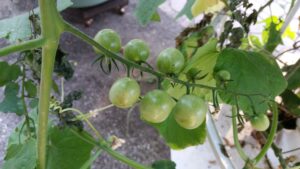
Thinking of aeroponics versus hydroponics is technically a misnomer.
Hydroponics, in distinction to its name beginning with hydro, generally means soil-less growing.
Indeed, hydroponics is technically growing plants in a water medium, although the term also encompasses any soil-less growing technique. It’s sometimes referred to as aquaponics.
Aeroponics, as a soil-less growing option, is a distinct variation. But still considered in the overarching hydroponic class.
Most true hydroponic growing systems have plant roots in the water; aeroponics differs by having them in the open air and being watered by various means.
So, now, with a basic understanding of the similarities and differences, let’s delve deeper.
Basic Principles: Understanding Aeroponics and Hydroponics
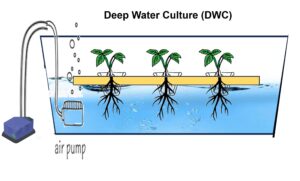
Plants with roots entirely submerged in water are the most commonly visualized hydroponic systems. Known as a deep water culture (DWC) system, this is one type of hydroponic system.
There are also nutrient film technique (NFT), ebb and flow, and drip systems.
Aeration of the nutrient solution is required in these systems, usually using an air stone like in fish tanks. Oxygen is one of the primary drivers of the exceptional growth of these systems.
- The NFT system provides a thin layer of water containing nutrients to move through the root system.
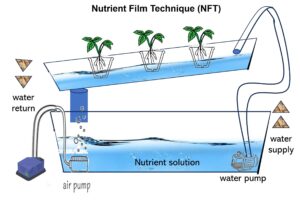
- Drip systems constantly drip on the plant or its root system.
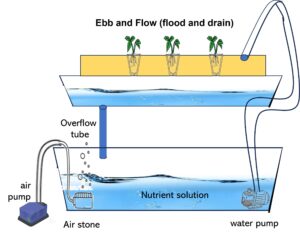
- Drip systems constantly drip on the plant or its root system.
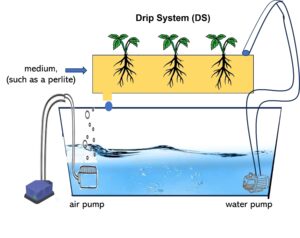
Aeroponic systems are slightly different. You have a low-pressure system (LPA), a high-pressure system (HPA), and another drip system. In these systems, the roots are constantly in the air instead of water.
- The LPA system produces large water droplets that spray the roots.
- The HPA system creates a mist to spray over the roots.
- The drip system uses a pump to move the water from the reservoir and gravity to drip the water back down through the plant roots.
A timer system controls the ebb and flow system and all three aeroponic methodologies.
Best Plants for Hydroponics and Aeroponics
Hundreds of plants can be grown in hydroponic and aeroponic systems.
Most systems focus on leafy vegetables, herbs, or flowers.
An aeroponic system can make growing many vegetables easier, including vining plants like tomatoes, zucchini, and cucumbers.
Vertical aeroponic systems use a caging system to hold up vines and carry the weight of the produce.
It is also possible to grow root vegetables. When creating your system, you must consider the size available for proper growth if you plan to produce these crops.
Almost any plant is suitable for hydroponic or aeroponic gardening with some planning in advance.
Analyzing Growth: Aeroponic Growth Rate and Hydroponic Yield Comparison
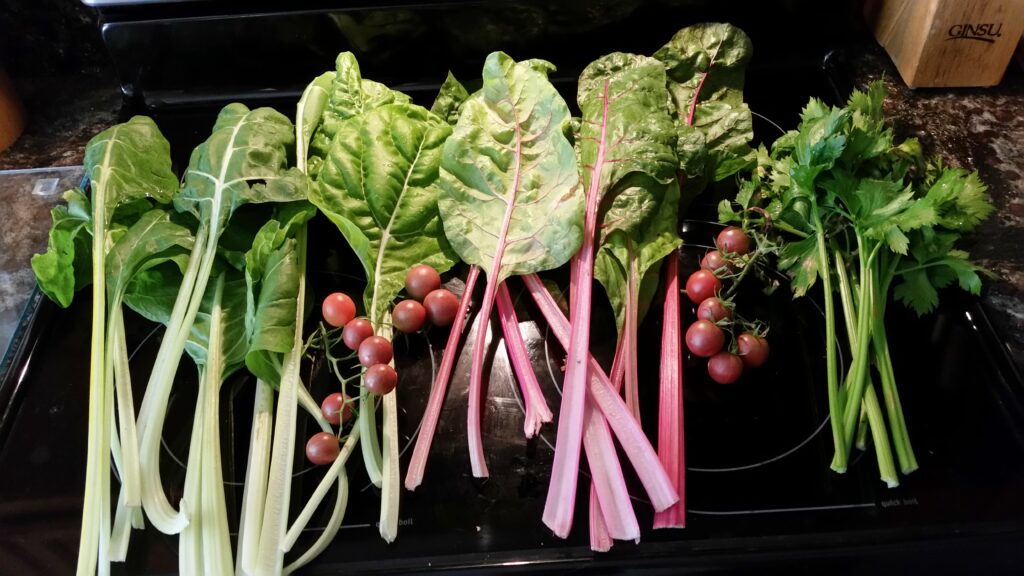
In all types of hydroponic systems, including aeroponics, the plant roots are directly in contact with the nutrient-rich water.
These techniques result in a much higher crop yield than growing in soil, with plants growing 30% to 50% faster than traditional farming.
Additionally, aeroponics allows for much greater oxygenation of the root system. This results in faster growth overall and usually larger crop yields as well.
A vertical aeroponic system requires 99% less land space than traditional gardening or agriculture, making it ideal for urban farming.
Hydroponic systems generally start with faster growth in the early stages, but an aeroponic system will surpass that as the plants mature.
Typically, aeroponic gardens produce larger plants, too.
Water Efficiency in Urban Farming: Aeroponics vs. Hydroponics
Then we get to water usage. Hydroponic systems use up to 98% less water than traditional farming.
Hydroponics will use more water than the aeroponic system. But in both cases, water is used from an enclosed pool.
Any water not absorbed by the plant roots is returned to the reservoir, using less water overall.
In addition, use organic nutrients in the water reservoir to make your harvest chemical-free.
While these types of systems are uniquely suited to urban farming, be sure to allow for the weight of the water reservoir when deciding where to put your garden.
Cost Comparison: Hydroponic Farming Costs vs. Aeroponic Systems
When deciding which system to use, you naturally consider the costs involved.
Both types of systems can be DIY projects. However, an aeroponic system will generally be more complex and expensive.
Or you can opt to purchase systems that are already designed and easy to assemble.
You also need to consider the power needs of the system you choose.
Almost all systems described will need a pump and possibly an airstone. These require power.
Fortunately, newer systems can be purchased with solar power adaptation, adding to the “green” nature of growing your own food.
Advantages of Hydroponic and Aeroponic Systems
As we have briefly mentioned, these systems require significantly less land area to produce a much higher crop yield.
Using aeroponics in vertical growing systems is optimal if you plan to grow for more than personal consumption. Strategic height use in your growing space allows each plant to receive sufficient sunlight (or indoor grow light).
Some commercially available aeroponic systems can grow from 20 to 28 plants in as little as 5 square feet.
Further, growing time to harvest can be as little as three to five weeks, depending on which plants you grow. This means lots of fresh greens, fruits, and vegetables for your family table or to share with your community.
Indoor growing means you can still have fresh vegetables in the dead of winter, too.
Navigating Challenges: Aeroponic Farming Disadvantages and Hydroponic Complexities
But no system is entirely perfect. There are some disadvantages too.
In DWC hydroponic systems, you must watch out for root rot since the roots stay submerged in water.
We also mentioned the need for power. You’ll need to plan for how to manage power outages.
Since these systems provide water at timed intervals using pumps or sprays, there is a need for dependable power.
Mechanical parts like pumps, hoses, and spray nozzles will need maintenance.
Water levels, as well as pH levels, nutrients, and temperature, also need monitoring.
However, if you use the system for your family, these maintenance and monitoring requirements can be an excellent way to enjoy family time while teaching your kids how to produce their own food.
Pest Management: Hydroponic Garden Pest Control Techniques
Since the plants are not in the soil, there is little chance they will pick up soil-borne diseases or insects.
But that doesn’t mean there are not some issues to consider.
High humidity created by these systems can form standing water that could become a breeding ground for insects and algae.
This is especially true if you grow indoors, such as in a greenhouse or sunroom.
It is essential to watch for signs of standing water or pests and take appropriate action.
Eco-Friendly Practices: Aeroponics Sustainability and Hydroponics Environmental Impact
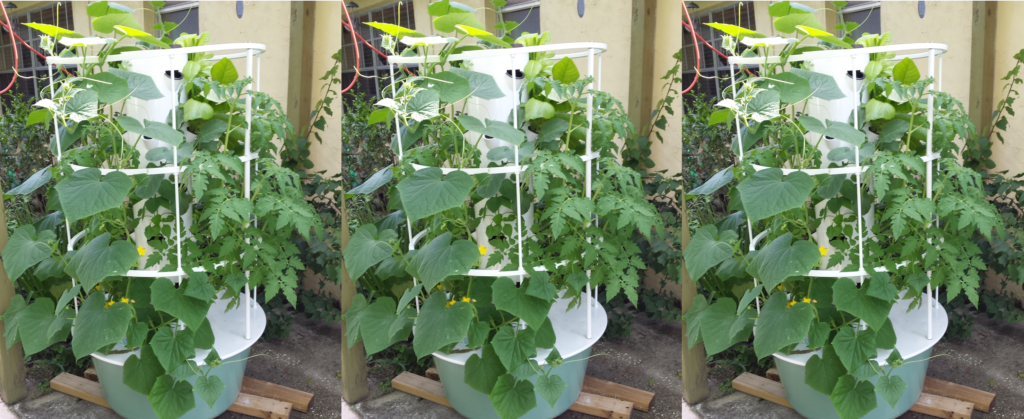
Hydroponic systems can yield as much as 20 times as much produce versus soil-based farming.
Aeroponics can often produce three times as much as soil farming but with a much faster maturity and harvest time.
Both systems require much less land area and significantly less total water usage.
It may seem counter-intuitive because the systems are water-based.
However, the unused water is retained in the system and reused again and again instead of becoming groundwater.
It is also easier to control the use of chemicals in these systems. You can use organic nutrients in place of fertilizers. And with fewer pest issues, little, if any, use of pesticides is needed.
Choosing the Right System for You
Now that you have learned the differences and similarities between hydroponic and aeroponic systems, you can choose what you want based on your goals.
Do you want a DIY project to feed your family fresher greens and vegetables?
Or are you looking at starting a commercial urban farm to provide fresh foods to your community?
Armed with the information you need, you can now make good choices, whatever your goal.
So get out there and start your urban farm!
